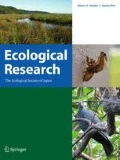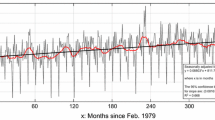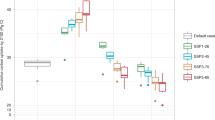Abstract
Investigating the role of forests for maintenance of the water cycle on land is critically important in the current situation of rapid global elimination of the natural vegetation cover. In this paper we contribute to the on-going discussion of the issue with two aspects. (1) Theoretical consideration of the water cycle on land reveals the importance of correct identification of independent and dependent terms in the water budget with respect to changing vegetation cover for understanding possible scenarios of water cycle change under anthropogenic impact. An important controlling influence of the vegetation cover is imposed on the outgoing fluxes of atmospheric moisture A − from land to the ocean, which is maximized in deserts and minimized in forested areas, while the dependencies for runoff and precipitation are the reverse. (2) Physical mechanisms allowing for efficient water retention and minimization of A − in forest ecosystems are investigated. Atmospheric water vapor is in aerostatic equilibrium when the temperature lapse rate is less than G = 1.9 K km−1 and out of aerostatic equilibrium when G > 1.9 K km−1. In the former case there are no vertical upward fluxes of the evaporated water. It is shown that the temperature profiles developed under the closed canopies of natural forests keep water vapor in aerostatic equilibrium preventing soil moisture loss to A −, in contrast to the situation in open ecosystems like grasslands. The analyzed evidence allows one to conclude that an intensive water cycle on land can be restored after recovery of natural, self-sustained closed canopy ecosystems on continent-wide areas.


Similar content being viewed by others
References
Acevedo OC, Moraes OLL, da Silva R, Fitzjarrald DR, Sakai RK, Staebler RM, Czikowsky MJ (2004) Inferring nocturnal surface fluxes from vertical profiles of scalars in an Amazon pasture. Glob Change Biol 10:886–894
Andreae MO, Rosenfeld D, Artaxo P, Costa AA, Frank GP, Longo KM, Silva-Dias MAF (2004) Smoking rain clouds over the Amazon. Science 303:1337–1342
Arora V (2005) Comment on ‘‘Optimized stomatal conductance of vegetated land surfaces and its effects on simulated productivity and climate’’ by A. Kleidon. Geophys Res Lett 32:L08708
Austin AT, Sala OE (2002) Carbon and nitrogen dynamics across a natural precipitation gradient in Patagonia, Argentina. J Veget Sci 13:351–360
Baerlocher F (1990) The Gaia hypothesis: a fruitful fallacy? Experientia 46:232–238
Bowman DMJS (2002) The Australian summer monsoon: a biogeographic perspective. Aust Geogr Stud 40:261–277
Breshears DD, Nyhan JW, Heil CE, Wilcox BP (1998) Effects of woody plants on microclimate in a semiarid woodland: soil temperature and evaporation in canopy and intercanopy patches. Int J Plant Sci 159:1010–1017
Bruijnzeel LA (2001) Hydrology of tropical mountain cloud forests: a reassessment. Land Use Water Resour Res 1:1–18
Bryant D, Nielsen D, Tangley L (1997) The last frontier forests: ecosystems and economies on the edge. World Resources Institute, Washington
Cochrane MA, Alencar A, Schulze MD, Souza CM, Nepstad DC, Lefebvre P, Davidson EA (1999) Positive feedbacks in the fire dynamic of closed canopy tropical forests. Science 284:1832–1835
Cowling SA (2004) Tropical forest structure: a missing dimension to Pleistocene landscapes. J Quat Sci 19:733–743
Dai A, Trenberth KE (2002) Estimates of freshwater discharge from continents: latitudinal and seasonal variations. J Hydrometeorol 3:660–687
da Rocha HR, Goulden ML, Miller SD, Menton MC, Pinto LDVO, de Freitas HC, Silva Figueira AME (2004) Seasonality of water and heat fluxes over a tropical forest in eastern Amazonia. Ecol Appl 14(Suppl):S22–S32
Doolittle WF (1981) Is nature really Motherly? CoEvolution Quat 29:58–63
Eagelson PS (2002) Ecohydrology: Darwinian expression of vegetation form and function. Cambridge University Press, Cambridge
Eltahir EAB, Bras RL (1996) Precipitation recycling. Rev Geophys 34:367–378
Engel VC, Stieglitz M, Williams M, Griffin KL (2002) Forest canopy hydraulic properties and catchment water balance: observations and modeling. Ecol Mod 154:263–288
Gorshkov VG (1984) Ecology of man. Leningrad Polytechnical Institute, Leningrad
Gorshkov VG (1995) Physical and biological bases of life stability. Springer, Berlin Heidelberg Newyork
Gorshkov VG, Gorshkov VV, Makarieva AM (2000) Biotic regulation of the environment: key issue of global change. Springer, Berlin Heidelberg Newyork
Gorshkov VG, Makarieva AM (2006) Biotic pump of atmospheric moisture, its links to global atmospheric circulation and implications for conservation of the terrestrial water cycle. Preprint 2655. Petersburg Nuclear Physics Institute, Gatchina, pp 47
Gorshkov VG, Makarieva AM, Gorshkov VV (2004) Revising the fundamentals of ecological knowledge: the biota–environment interaction. Ecol Complexity 1:17–36
Gorshkov VG, Makarieva AM, Pujol T (2002) Radiative-convective processes and changes of the flux of thermal radiation into space with increasing optical thickness of the atmosphere. Proceedings of the XXXVI Winter School of Petersburg Nuclear Physics Institute, Nuclear and Particle Physics, pp 499–525
Hayward B (2005) From the mountain to the tap: how land use and water management can work for the rural poor. Rowe the Printers, Hayle
Kaimowitz D (2005) Forests and water: a policy perspective. J For Res 9:289–291
Karlsson IM (2000) Nocturnal air temperature variations between forest and open areas. J Appl Met 39:851–862
Koren I, Kaufman YJ, Remer LA, Martins JV (2004) Measurement of the effect of Amazon smoke on inhibition of cloud formation. Science 303:1342–1345
Kruijt B, Malhi Y, Lloyd J, Nobre AD, Miranda AC, Pereira MGP, Culf A, Grace J (2000) Turbulence statistics above and within two Amazon rain forest canopies. Boundary-Layer Meteorol 94:297–331
Lyons TJ (2002) Clouds prefer native vegetation. Meteorol Atmos Phys 80:131–140
Mahrt L, Lee X, Black A, Neumann H, Staebler RM (2000) Nocturnal mixing in a forest subcanopy. Agr For Met 101:67–78
Makarieva AM, Gorshkov VG, Losev KS, Dovgalyuk YA (2004) Dependence of greenhouse effect on the concentration of greenhouse components in the Earth atmosphere in the presence of non-radiative energy flows. Trans Earth Sci Sect Russ Acad Nat Sci 12:125–135
Makarieva AM, Gorshkov VG, Pujol T (2003) Height of convective layer in planetary atmospheres with condensable and non-condensable greenhouse substances. Atmos Chem Phys Discuss 3:6701–6720
Marengo JA (2005) Characteristics and spatio-temporal variability of the Amazon river basin water budget. Clim Dyn 24:11–22
Martius C, Höfer H, Garcia MVB, Römbke J, Förster B, Hanagarth W (2004) Microclimate in agroforestry systems in central Amazonia: does canopy closure matter to soil organisms? Agrofor Syst 60:291–304
Mitchell J (1989) The “greenhouse” effect and climate change. Rev Geophys 27:115–139
Nepstad D, Lefebvre P, da Silva UL, Tomasella J, Schlesinger P, Solórzano L, Moutinho P, Ray D, Benito JG (2004) Amazon drought and its implications for forest flammability and tree growth: a basin-wide analysis. Glob Change Biol 10:704–717
Nicholson SE (2000) The nature of rainfall variability over Africa on time scales of decades to millenia. Glob Planet. Change 26:137–158
Pielke RA (2001) Influence of the spatial distribution of vegetation and soils on the prediction of cumulus convective rainfall. Rev Geophys 39:151–177
Raval A, Ramanathan V (1989) Observational determination of the greenhouse effect. Nature 342:758–761
Rodríguez-Iturbe I (2000) Ecohydrology: a hydrological perspective of climate–soil–vegetation dynamics. Water Resour Res 23:349–357
Rodríguez-Iturbe I, Porporato A (2004) Ecohydrology of water controlled ecosystems: soil moisture and plant dynamics. Cambridge University Press, Cambridge, UK
Rosenfeld D, Rudich Y, Lahav R (2001) Desert dust suppressing precipitation: a possible desertification feedback loop. Proc Natl Acad Sci USA 98:5975–5980
Savenije HHG (1995) New definitions for moisture recycling and the relationship with land-use change in the Sahel. J Hydrol 167:57–78
Shuttleworth WJ (1989) Micrometeorology of temperate and tropical forest. Philos Trans R Soc Lond B 324:207–228
Shuttleworth WJ, Gash JHC, Lloyd CR, Moore CJ, Roberts J, Marques-Filho AO, Fisch G, Filho VPS, Ribeiro MNG, Molion LCB, Sá LDA, Nobre JCA, Cabral OMR, Patel SR, Carvalho JM (1985) Daily variations of temperature and humidity within and above Amazonian forest. Weather 40:102–108
Szarzynski J, Anhuf D (2001) Micrometeorological conditions and canopy energy exchanges of a neotropical rain forest (Surumoni-Crane Project, Venezuela). Plant Ecol 153:231–239
Watson FGR, Vertessy RA, Grayson RB (1999) Large scale modelling of forest hydrological processes and their long-term effect on water yield. Hydrol Process 13:689–700
Weaver CP, Ramanathan V (1995) Deductions from a simple climate model: factors governing surface temperature and atmospheric thermal structure. J Geophys Res 100D:11585–11591
Wentz FJ, Schabel M (2000) Precise climate monitoring using complementary satellite data sets. Nature 403:414–416
Zeller KF, Nikolov NT (2000) Quantifying simultaneous fluxes of ozone, carbon dioxide and water vapor above a subalpine forest ecosystem. Environ Pollut 107:1–20
Zhang L, Dawes WR, Walker GR (2001) Response of mean annual evapotranspiration to vegetation changes at catchment scale. Water Resour Res 37:701–708
Zimmermann R, Schulze E-D, Wirth C, Schulze E-E, McDonald K, Vygodskaya N, Ziegler W (2000) Canopy transpiration in a chronosequence of Central Siberian pine forests. Glob Change Biol 6:25–37
Acknowledgments
We thank AD Nobre, M Hodnett, J Tomasella, LA Cuartas, C Nobre and MD Oyama for discussion of the various aspects of the problem of vegetation impact on the terrestrial water cycle. Comments of an anonymous referee are sincerely acknowledged. Special thanks are due to DD Breshears for most helpful suggestions with regard to the manuscript’s structure. This work was partially supported by the U.S. National Science Foundation and the University of California Agricultural Experiment Station (BLL).
Author information
Authors and Affiliations
Corresponding author
About this article
Cite this article
Makarieva, A.M., Gorshkov, V.G. & Li, BL. Conservation of water cycle on land via restoration of natural closed-canopy forests: implications for regional landscape planning. Ecol Res 21, 897–906 (2006). https://doi.org/10.1007/s11284-006-0036-6
Received:
Accepted:
Published:
Issue Date:
DOI: https://doi.org/10.1007/s11284-006-0036-6




